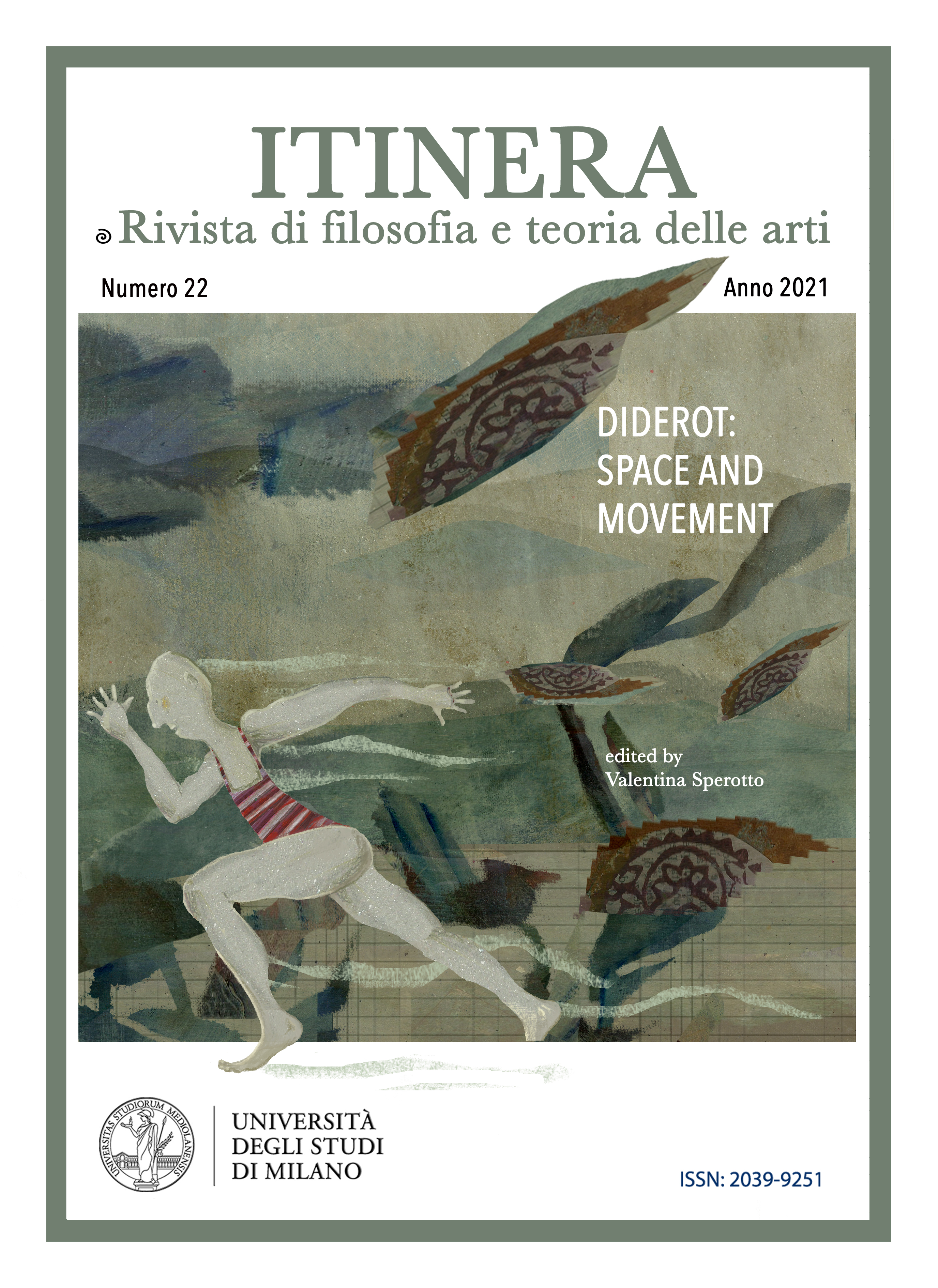L’esprit du lieu et son fantôme.La restauration créative d’Edoardo Tresoldi
DOI:
https://doi.org/10.54103/2039-9251/16937Parole chiave:
Edoardo Tresoldi, Martin Heidegger, Jacques Derrida, genius loci.Abstract
Abstract: the paper considers the creative restoration of an early Christian basilica in Siponto, Apulia, realized by Italian artist Edoardo Tresoldi. Tresoldi resorts to the wire mesh as an artistic material: the restored basilica thus results in a monumental but evanescent building. After an introduction describing the public artwork, the paper will unfold in two main sections. In the first one, the focus will be on the concept of genius loci as a distinctive character of Tresoldi’s poetics. Through an Heideggerian lens, the stress will be put on the existential value of dwelling, which is highlighted by the restored church. The second section will focus on the ghostly and uncanny (unheimlich) appearance of the basilica. Thanks to authors such as Derrida and Didi-Huberman, it will be shown that a genius deloci is at work in the site as well, calling into question the different temporalities that animate the basilica. Genius loci and genius deloci will prove as a conceptual couple capable of providing us with an access to the artwork; nevertheless, they will not be understood as a dichotomy, i.e. as mutually exclusive concepts, but as opposite notions that “haunt” each other and that cannot but be used together, in the postmodernist fashion of double-coding.
Riferimenti bibliografici
Aebersold, R., L’archéologie de l’avenir, in “ Les nouvelles de l’archéologie ”, CLI, 2018, p. 71.
Böhme, G., Griffero, T., Thibaud, J.P., Architecture and Atmosphere, Tapio Wirkkala Rut Bryk Foundation, Espoo 2014.
Chiodi, S., Genius loci. Anatomia di un mito italiano, Quodlibet, Macerata 2021.
Del Sole, F., The Architectural Illusion of Edoardo Tresoldi : The Reconstruction of the Basilica of Siponto, in “ Athens Journal of Architecture ”, VII/2, 2021, pp. 257-274.
Derrida, J., Signature événement contexte, in Id. Marges de la philosophie, Les Éditions de Minuit, Paris 1972, pp. 365-393.
Derrida, J., Répondre du Secret, inédit, 1991/1992. Séminaire tenu à l’Ecole des Hautes Etudes en Sciences Sociales (EHESS), conservé à l’Institut Mémoire de l’Edition Contemporaine (IMEC).
Derrida, J., Spectres de Marx, Éditions Galilée, Paris 1993.
Didi-Huberman, G., Génie du non-lieu. Air, poussière, empreinte, hantise, Les Éditions de Minuit, Paris 2001.
Didi-Huberman, G., La ressemblance par contact. Archéologie, anachronisme et modernité de l’empreinte, Les Éditions de Minuit, Paris 2008.
Eco, U., Opera aperta. Forma e indeterminazione nelle poetiche contemporanee (1962), Bompiani, Milano 201610.
Farrell Krell, D., Das Unheimliche: Architectural Sections of Heidegger and Freud, in “ Research in Phenomenology ”, XXII/1, 1992, pp. 43-61.
Freud, S., L’inquiétante étrangeté (1919), in Id. Essais de psychanalyse appliquée, traduit par M. Bonaparte et E. Marty, Gallimard, Paris 1933, pp. 163-210.
Grasseni, C., Luoghi comuni. Antropologia dei luoghi e pratiche della visione, Lubrina, Bergamo 2009.
Griffero, T., Atmosferologia. Estetica degli spazi emozionali, Laterza, Roma-Bari 2013.
Hartog, F., Régimes d’historicité. Présentisme et expériences du temps, Seuil, Paris 2003.
Heidegger, M., Bâtir habiter penser (1951), in Id. Essais et conférences, traduit par A. Préau, Gallimard, Paris 1958, pp. 170-193.
Heidegger, M., L’origine de l’œuvre d’art (1936), in Id. Chemins qui ne mènent nulle part, traduit par W. Brokmeier, Gallimard, Paris 1962, pp. 7-68.
Heidegger, M., Être et temps (1927), traduit par F. Vezin, Gallimard, Paris 1986.
Heidegger, M., Prolégomènes à l'histoire du concept de temps (1925), traduit par A. Boutot, Gallimard, Paris 2006.
Innaco, C., L’altra metà della Rovina. Il progetto di Edoardo Tresoldi per la Basilica di Siponto, in “ PsicoArt – Rivista di arte e psicologia ”, IX, 2019, pp. 1-24.
Jameson, F., Archaeologies of the Future : The Desire Called Utopia and other Science Fictions, Verso, London 2005.
Jencks, C.A., The Language of Post-Modern Architecture, Academy Editions, London 1977.
Jencks, C.A., The Story of Post-Modernism. Five Decades of Ironic, Iconic and Critical in Architecture, Wiley, Chichester 2011.
Merleau-Ponty, M., Le cinéma et la nouvelle psychologie, in “ Les Temps Modernes ”, XXVI, 1947, pp. 930-943.
Norberg-Schulz, Ch., Genius Loci. Paysage Ambience Architecture, traduit par O. Seyler, Mardaga éditeur, Sprimont 1981.
Rossi, A., L’architettura della città, Marsilio, Padova 1966 ou F. Purini, Luogo e progetto, Magma, Roma 1976.
Tononi, F., Aesthetic Response to the Unfinished: Empathy, Imagination and Imitation Learning, in “ Aisthesis ”, XIII/1, 2020.
Vattimo, G., Poesia e ontologia, Mursia, Milano 1967.
Vattimo, G., L’arte dell’oscillazione, in Id. La società trasparente (1989), Garzanti, Milano 20113.
Vidler, A., The Architectural Uncanny. Essays in the Modern Unhomely, Massachussets Institute of Technology, Cambridge (MA) 1992.
Vitta, M., Dell’abitare. Corpi spazi oggetti immagini, Einaudi, Torino 2008.
Wong, L., Adaptive Reuse. Extending the Lives of Buildings, Birkhäuser, Basel 2017.
Dowloads
Pubblicato
Fascicolo
Sezione
Licenza
Gli autori che pubblicano su questa rivista accettano le seguenti condizioni:
1. Gli autori mantengono i diritti sulla loro opera e cedono alla rivista il diritto di prima pubblicazione dell'opera, contemporaneamente licenziata sotto una Licenza Creative Commons - Attribuzione - Condividi allo stesso modo 4.0 internazionale che permette ad altri di condividere l'opera indicando la paternità intellettuale e la prima pubblicazione su questa rivista.
2. Gli autori possono aderire ad altri accordi di licenza non esclusiva per la distribuzione della versione dell'opera pubblicata (es. depositarla in un archivio istituzionale o pubblicarla in una monografia), a patto di indicare che la prima pubblicazione è avvenuta su questa rivista.
3. Gli autori possono diffondere la loro opera online (es. in repository istituzionali o nel loro sito web) prima e durante il processo di submission, poiché può portare a scambi produttivi e aumentare le citazioni dell'opera pubblicata (Vedi The Effect of Open Access).





